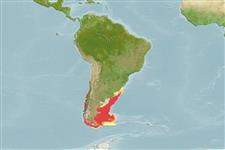分類 / Names
共通名の | 類義語 | Catalog of Fishes(部類, 種) | ITIS | CoL | WoRMS | Cloffa
Environment: milieu / climate zone / depth range / distribution range
生態学
海 底生の; 深さの範囲 ? - 40 m (Ref. 120403). Temperate; 4°C - 19°C (Ref. 104541); 18°S - 57°S, 75°W - 52°W
Southeast Pacific: central Chile to the Strait of Magellan.
Length at first maturity / サイズ / 重さ / 年齢
Maturity: Lm 103.5, range 94 - 100 cm
Max length : 152 cm TL オス/雌雄の選別がない; (Ref. 120403)
簡単な記述
形態学 | 形態計測学
This medium-sized speies of Dipturus (up to at least 118.0 cm TL) is distinguished from its congeners by the following set of characters: when fresh, the dorsal surface of body is plain brownish to greyish, with some lighter small spots randomly distributed dorsally; one red to purple ocellus over center of each pectoral fin; ocelli with well-defined margins, irregular in shape, but often indistinguishable in fixed specimens; ventrally, white to grey with lighter patches over area of gill openings and beneath mouth; area flanking rostral cartilage membranous and slightly translucent and opaque and yellowish when fixed. Further differs by having a relatively broad disc with angular apices, its width 76.4 (75.0; 77.0) % TL; snout relatively short and broad; tail longer in males (42.2 [40.8] % TL) than in female voucher ([38.8] % TL); ventral head length 35.1 (34.2; 37.7) % TL; preorbital snout length 2.4 (2.9; 2.9) times distance between orbits; orbit diameter 0.5 (0.5; 0.6) of inter-orbital width; in males, the dorsal surface of disc and tail with central longitudinal band of dermal denticles extending from anterior margin of rostral cartilage to tail, including anterior margins of dorsal and caudal fins; a thin band of dermal denticles at anterior margins of pectoral fins, extending from anterior fontanelle to front line of alar thorn patches; dorsal surface of disc and tail of females covered with small dermal denticles, except for external margins of pectoral fins, pelvic fins, and area surrounding caudo-central thorns; with orbital thorns; a single nuchal thorn is often absent; both sexes without scapular thorns; a patch of malar thorns only in adult males; alar thorns only in adult males; medial-dorsal and lateral-dorsal thorns may be present in large specimens, especially in large females; small central-caudal thorns mostly arranged in longitudinal pairs in males and females, with two additional longitudinal rows of fine, sharp and posteriorly oriented lateral-caudal thorns may be present in large specimens; ventral sensory pores are small, distinct, black-edged, most abundant on snout and around mouth, scattered over area between gill openings, sparsely spaced on abdominal area and pectoral fins (Ref. 120403).
Oviparous (Ref. 50449). Reported size at hatching and incubation period 17.2 cm TL and 252 days, respectively (Ref. 120403). Eggs have horn-like projections on the shell (Ref. 205). Inhabits sandy and muddy bottoms at depths (Ref. 104541).
Life cycle and mating behavior
成熟 | 繁殖 | 放精 | 卵 | 生産力 | 幼生
Oviparous, paired eggs are laid. Embryos feed solely on yolk (Ref. 50449). Eggs have horn-like projections on the shell (Ref. 205).
Concha, F.J., J. Caira, D.A. Ebert and J.H.W. Pomperi, 2019. Redescription and taxonomic status of Dipturus chilensis (Guichenot, 1848), and description of Dipturus lamillai sp. nov. (Rajiformes: Rajidae), a new species of long-snout skate from the Falkland Islands. Zootaxa 4590(5):501-524. (Ref. 120403)
IUCNのレッドリストの状況は (Ref. 130435)
絶滅危惧 (EN) (A2bd); Date assessed: 06 February 2019
Human uses
より多くの情報
協力者画像Stamps, Coins Misc.音シガテラ(食中毒の名前)速度泳ぐ 型式カマOtoliths脳視覚
用具
特記事項
XMLをダウンロードして下さい
インターネットの情報源
Estimates based on models
Preferred temperature (Ref.
123201): 4.5 - 10.6, mean 6.7 °C (based on 334 cells).
Phylogenetic diversity index (Ref.
82804): PD
50 = 0.6250 [Uniqueness, from 0.5 = low to 2.0 = high].
Bayesian length-weight: a=0.00282 (0.00133 - 0.00596), b=3.25 (3.08 - 3.42), in cm total length, based on LWR estimates for this Genus-body shape (Ref.
93245).
栄養段階 (Ref.
69278): 4.5 ±0.6 se; based on diet studies.
Generation time: 9.5 (8.1 - 12.6) years. Estimated as median ln(3)/K based on 13
growth studies.
回復力 (Ref.
120179): 低い, 4.5年~14年の倍増期間の最小個体群 (Fec assumed to be <100).
Fishing Vulnerability (Ref.
59153): Very high vulnerability (90 of 100).
Nutrients (Ref.
124155): Calcium = 3.18 [0.45, 55.95] mg/100g; Iron = 0.198 [0.018, 2.222] mg/100g; Protein = 15.2 [12.7, 18.3] %; Omega3 = 0.698 [0.304, 1.673] g/100g; Selenium = 18.6 [3.7, 89.1] μg/100g; VitaminA = 4.17 [0.30, 53.72] μg/100g; Zinc = 0.25 [0.02, 2.75] mg/100g (wet weight); based on
nutrient studies. 